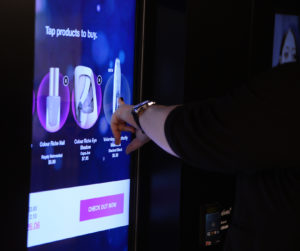UK retailers are facing unprecedented pressure when it comes to keeping consumers shopping on the high-street. Amidst a climate of exponential e-commerce growth and economic uncertainty, retail sales continue to fluctuate in the UK. Despite this, February 2017 saw retail sales increase 3.7 per cent compared with February 2016, indicating that the high-street is by no means a lost cause.
One significant way that retailers are trying to keep consumers on the high street is by creating more interactive and immersive shopping experiences, one that they would not otherwise receive by shopping online. This is the key to making sure shopping is seen as just that, an experience. Retailers are addressing this by incorporating intelligent digital signage networks made up of touchscreen information stations, interactive menus and window displays, and LED screens displaying live social media feeds.
But with the implementation of these tools, comes the need to produce content to populate the platforms. This can often be a sticking point for retailers who are unsure on how best to use the technology to ultimately drive more sales and customer engagement. It’s all very well having flashy technology but if it isn’t driving higher sales, what’s the point?
Implementing the right Content Management System (CMS) platform is essential to help retailers get the most out of these technologies and understand the ROI of intelligent digital signage and interactive instore experiences. This is especially true considering that 43% of shoppers that can’t find the information instore leave frustrated. Information needs to be targeted, relevant and ultimately, visible across multiple platforms.
A CMS platform can be considered the backbone to any digital signage network, enabling retailers to upload and promote content that will populate any screens instore and also mobile ecommerce sites to attract people to the store and then converting them. This content needs to be enticing, attention grabbing and slick.
But there are some key considerations for retailers looking to transform their instore experiences in this way:
- Be able to access data and analytics – Having interactive displays is a great way of gaining data about your customers. For example, having a screen instore which enables customers to flick through an ‘e-wardrobe’ can help you gather data about which items are most popular. Your CMS should have extensive analytics capabilities so that you can actually see that data and understand how your content is being consumed so that this can be used to guide wider marketing and merchandising decisions. This can be in the form of anonymous video analytics for example and other proof of play solutions.
- Enable you to create and publish content across all devices – Omnichannel customer engagement remains a huge focus for retailers hence it is important that you can use a CMS platform to engage customers both instore and on mobile. Digital signage is more than just screens. If customers can view an interactive window display, get directed to an app and then go on their mobile to claim an exclusive offer, that is a powerful way to get customers in your store. You need a CMS platform that can enable you to produce and promote content on these multiple platforms and importantly, the same platform. Retailers can then produce content once and make it public everywhere, across a whole network of digital signage touchpoints in order to follow the customer journey and create a seamless experience.
- Let you target specific consumers with targeted information – Digital signage is ultimately pointless if those viewing it cannot take immediate action. It’s vital that customers feel compelled to act on the messaging displayed on the signs and an effective way to do this is by being able to segment content.
For example, a real-time twitter feed can be displayed in store and offer customers an exclusive 20 per cent off if they tweet the company using a certain hashtag and send an image of them wearing an item they want to purchase. Not only does this create increased interaction with the brand on social media, but the content appears targeted and specific to that consumer in that store. The reach is further amplified as the message then reaches that consumer’s social network, each of who could also be potential customers. It is the CMS platform that is powering this interaction and enabling the retailer to reach the consumer in that way.
- Enable you to integrate new devices with ease – Having a CMS platform that is scalable to any business is key for retailers looking to create, manage and deploy content across a variety of end points including screens, kiosks and mobile. For example, if you are keen to integrate a series of interactive screens around a large store but the information on those screens cannot be coordinated or managed on the same system, then it’s not only inefficient but counterproductive. It should be seamless to integrate new devices into your digital signage network and messages need to be consistent to engage shoppers.
CMS platforms should be considered the unsung hero of interactive instore experience and ultimately power any digital signage network. The platform maybe seen as merely a place to house content, but it should be seen as the gateway to creating an interactive retail experience to keep consumers coming back to the high street. Shopping needs to be considered fun and entertaining again, and creating an immersive, experiential experience through interactive displays is a powerful way to do so. All of which can be powered by a state of the art CMS platform.
There are many CMS platforms available to retailers, but you need to make sure that you invest in one that has the infinite flexibility to deliver all there is to offer when it comes to analysing consumer data and managing and deploying content across all consumer touch points.






